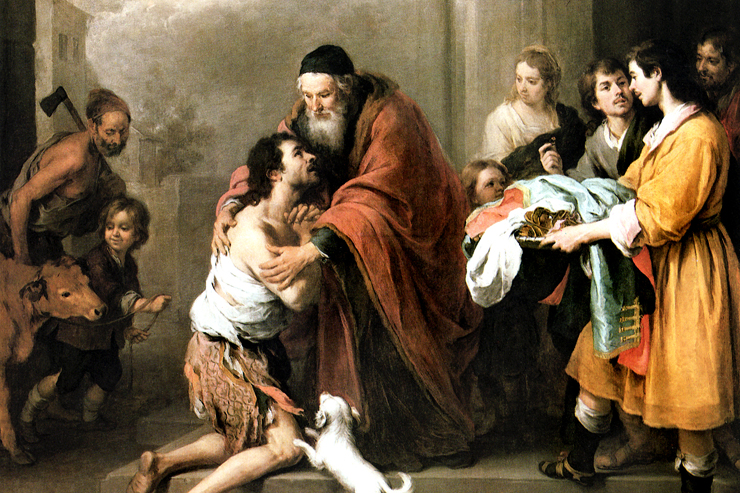
“Adoration of the Lamb”
by van Eyck
Some months ago I was down to take a wedding on a Saturday. The couple had been prepared by the deacon. The groom was from a nominally Catholic family, the girl was unbaptized.
So the wedding party turned up for the rehearsal on the Friday and, as usual, people were in high spirits, but in this case there was some rolling of eyes and poor behavior from some of the non-Catholics. I was told by one of the assistants that they were mocking the Catholic Church and making light of what was going on.
So, as I conducted the rehearsal I explained about the Catholic view of marriage and discussed God’s love and our human loves and what the different elements of the ceremony actually meant. Then, the next day, as the wedding began I welcomed everyone and explained that we call this ceremony the “solemnization of marriage” and that, while it is a joyful event, it is also a solemn religious ritual. I explained that God is present here and I invited them to join in with the prayers and treat the ceremony as solemnly as possible so that it would be as beautiful and meaningful as possible for the bride and groom.
The marriage went on, and I noticed that everyone actually responded. People who had been casual and slouchy were standing erect and tall and silent. They had put their cameras away. They knelt reverently and listened carefully to the readings and homily. They were caught up in the ceremony – and this was especially noticeable amongst the non-Catholics.
Then when it came to the blessing of the rings the ten year old boy stepped forward with the rings pinned to a pillow and he was weeping freely. I looked across and saw that one of the beefy groomsmen was also wiping away a tear. The matron of honor was weeping and so was another bridesmaid. Now I know people always cry at weddings, but this was quite extraordinary and I sensed that what was making them weep was a real and tangible presence of God – and that their awareness of his presence was empowered by the fact that they took my words about the solemnity of the ritual seriously.
How beautiful it is, and how necessary, therefore for all of our sacraments to be celebrated with sacred solemnity. You see, what happens is that sacred solemnity and the formality of ritual touches places deep within the human heart that cannot be touched in any other way. Ritual – with it’s symbolic actions and solemn words – helps us connect with the places that are too deep for ordinary words and actions.
When a person attends Mass this is why he should dress better and carry himself better and listen to the words and recite the words with suitable solemnity and dignity–because all of this connects his conscious mind with a better person than he knew he was–a sacred solemn person–a person who is usually buried within the hurly-burly and shallowness of everyday life.
This is why our liturgy should be beautiful, because beauty is the language of worship. This is why our music should be sacred and solemn. This is why we should spend money on building beautiful churches. This is why we should train our altar servers and lectors and eucharistic ministers to serve with dignity and solemnity and a sacred manner.
But we have forgotten all of this. Our grandparents and great grandparents understood it, but we have been caught up in the tyranny of utilitarianism. Our churches are mere auditoria. Our music all has to be ‘meaningful’ and that usually means sentimental and trite. Our religion (because we have forgotten the supernatural) has become a mere fellowship and a method to ‘make the world a better place.’ All of this driven by the need for everything to be useful and cost effective and efficient. “Oh, the vulnerability of beauty in a world of useful things!”
I will always remember the tears of that ten year old ring bearer and the tears of the congregation at that wedding. It took non-Catholics responding naturally and openly to the liturgy to remind me what it is all about, and to give me the reminder that through the sacred and the solemn we are transformed at a deeper level than we can imagine.
Fr. Dwight Longenecker is the author of “Listen My Son” – a commentary on the Rule of St Benedict for families. Visit Fr. Dwight’s website to buy a copy here.
Fr. Dwight Longenecker is the parish priest of Our Lady of the Rosary Church in Greenville, South Carolina. He is author of thirteen books on the Catholic faith. Praying the Rosary for Inner Healing is available in Catholic bookshops and through his website: dwightlongenecker.com
Visit Fr. Longenecker on Facebook: http://www.facebook.com/frlongenecker
Sign up for Fr. Longenecker’s free weekly newsletter FaithWorks! which gives practical advice on the practice of the Catholic faith.
Please post your comments and questions below.
If you appreciate our writing, please use both the Share and Recommend buttons to tell your family and friends about this article. Help us help others to integrate their faith throughout their daily life.
Thank you! – The Editors
Print this entry













